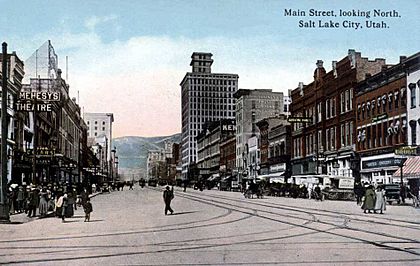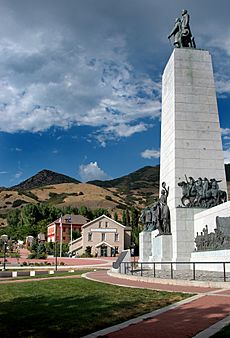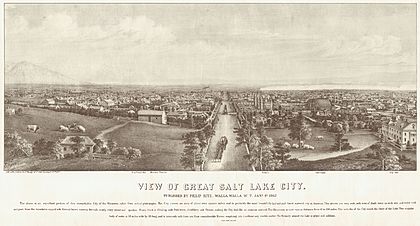Mormon settlement techniques of the Salt Lake Valley facts for kids
The Church of Jesus Christ of Latter-day Saints (often called Mormons or Latter-day Saints) settled the Salt Lake Valley. They also created over 500 communities in the American West. Many historians see this as a huge achievement in American city building. The Latter-day Saints moved from place to place until they found a permanent home. This was in the Great Basin area of the Rocky Mountains.
This group was known for working together to build new homes. In 1847, they traveled in large groups across the Great Plains of the United States. They reached what is now northern Utah. Led by Brigham Young, they used their experience to settle there. The Church provided important leadership, helping everyone work together. Salt Lake City, the Church's headquarters, is their most famous success. Many other settlements in the area were also very successful. They used techniques like the farm village, plats, and the grid. These were key for starting and growing this empty area. The Latter-day Saints' presence helped finish the Transcontinental Railroad. Promontory, Utah was where the Union Pacific and Central Pacific lines connected. This area was often called "the Crossroads of the West." It became a major stop for people traveling west, especially during the California Gold Rush. At first, it was a farming community. But the Latter-day Saints soon became strong in industry, using mines, factories, and railroads.
Contents
Why Did They Settle Here?
The Church of Christ was the original name of the church. It was founded by Joseph Smith in New York in 1830. Many early members came from the American northeast. They knew standard farming methods and how to organize towns. But church members faced unfair treatment and even violence from angry groups. This caused Smith and his followers to move often. They built communities wherever they went.
Smith wanted to build Zion. This was a place where his people could live together peacefully. His "City of Zion" plan was based on farming and being self-sufficient. Each family would have a small city lot for their home and garden. Large fields for crops and barns would surround the city. The Latter-day Saints started building in Kirtland, Ohio and parts of Missouri. These included Jackson County, Missouri and Far West, Missouri. Then they moved their headquarters to Nauvoo, Illinois. They changed Nauvoo from a few log houses to a busy city. But they faced more intense problems. Their leader Joseph Smith was killed. So the Latter-day Saints decided to leave again. They moved from the Midwest to the Salt Lake Valley. Their new leader, Brigham Young, guided them.
How Did the Church Lead the Way?
The Church of Jesus Christ of Latter-day Saints was the main force behind settling the Salt Lake Valley. Most people living there were church members. This group knew how to build towns. They all lived and worked together, promoting the idea of Zion. The Latter-day Saints moved not for money or fame, but for their religion.
Since its early days, sharing their beliefs was important to the Church. Efforts to gain more followers and bring them to Zion helped many people move to Utah. This provided the workers needed for settlement. The Perpetual Emigration Fund was set up to help pay for converts to travel to Utah. Brigham Young had a vision that the "desert blossom as a rose." This vision came true as thousands joined the Latter-day Saints in the Salt Lake Valley. They greatly helped with their mission.
Church and Government Working Together
Most people in the Salt Lake Valley were Latter-day Saints. So the Church held a lot of power. It provided order, much like a government. They set up a system called a Theodemocracy. This meant that the church and government were closely linked. The Church has leaders who are not paid professionals. This starts with the president and his counselors. They form the First Presidency and oversee everything. Then there are the Quorum of the Twelve Apostles and other general authorities. They are in charge of specific areas. Below them are local leaders of stakes and wards.
There were also church courts that handled disagreements, but without lawyers. Brigham Young was the main leader. His authority flowed down to all the settlements. The Church's organization and leadership greatly helped plan and carry out the settlements. The men Young chose were often strong leaders. They had a lot of experience with building new communities.
More non-Mormons started moving in. Also, the Latter-day Saints wanted Utah to become a state. So the Church changed its system. They set up a more common type of government. They proposed the State of Deseret. It had three parts: legislative (making laws), judiciary (courts), and executive (carrying out laws). However, the Utah Territory was formed by Congress in 1850 instead. Brigham Young became its governor. Even with this new government, the Church's influence was still very strong. Church leaders taught their people that they were building the Kingdom of God on earth. This was like ancient Israel. The leadership of the Latter-day Saints under Young was described as a very organized and effective system.
Brigham Young's Leadership
The story of settling the Great Basin is closely tied to Brigham Young. For the Latter-day Saints, their prophet Brigham Young was God's messenger. So his words were seen as God's words. Under his direction, Salt Lake City was built as the headquarters. Other areas were also developed under his careful watch. Young was a skilled leader. He was different from the Church's founder, Joseph Smith. Young inspired his followers with his practical way of doing things. He was a good organizer and manager. His followers respected, admired, and loved him.
When Young first saw the Salt Lake Valley, he declared: "This is the place." This ended his people's long journey. It marked the new spot where they would begin to settle. Orson Pratt immediately surveyed the area. He marked the site for the temple and planned Salt Lake City. After starting the first settlement, Young sent explorers to check out the rest of the Salt Lake Valley. These included men like Albert Carrington and Jesse Little. After hearing their reports, Young sent groups of church leaders and skilled workers to specific places. Young personally chose these men. They were given a church assignment to settle their area. He would then regularly check on their progress. He often visited and gave strong feedback. Young believed that being isolated and working hard would build character. The Salt Lake Valley seemed perfect for this. Young realized more and more each month how many resources the valley had. With many people ready to work, these resources could be fully used.
How They Settled the Valley
The Land They Found
The Intermountain West was "drier and colder." It was also "more rugged" and "less accessible." This made it very different from the Mississippi River Valley, where they used to live. The Salt Lake Valley was surrounded by mountains: the Wasatch Mountains to the east, the Oquirrh Mountains to the west, and Traverse Ridge to the south. The Great Salt Lake was to the northwest. This geography gave them the isolation they wanted from other settlers. Church leaders learned about the area from trappers and explorers. Some reports, like Lansford Hastings', said the area was not good for permanent settlements. However, John Fremont's report was more positive. This helped the Church leaders choose the Salt Lake Valley as their destination.
Starting a New Life
The Latter-day Saints arrived late in the season. They had to quickly plant crops like potatoes and corn. This was to feed themselves through the winter and have seeds for spring. A man named Jim Bridger had told them nothing would grow in the Salt Lake Valley. This was mainly because the ground was so hard. It was so hard that it broke some of the pioneers' plows. To soften the ground, they built a dam in nearby City Creek. They flooded the ground, and it worked. Some Latter-day Saints had learned irrigation (watering crops) techniques while on missions, like in Italy. So they knew how to "dam streams and channel water in ditches to irrigate the crops." With twenty years of experience settling, they were well on their way. However, the first year was very difficult. They barely prepared for the harsh winter. Looking back, it's amazing they survived the first ten years. They faced strong winds, rains, snows, frosts, and insect pests.
Building Salt Lake City
Brigham Young decided where the Church's headquarters would be. He publicly announced the site for the Salt Lake Temple. He said, "Here we will build a temple to our God." The area around it was planned right away. It would be the heart of their new city. One of the first buildings was "the bowery." This was a simple structure used temporarily for worship and school. A fence was built around the city center. This protected them from Native Americans and cold winter winds. Inside the fence, they built log homes and adobe houses. A school was built, but at first it had no desks or chairs. Later, the Latter-day Saints made tables from wagon parts. They used cloth stretched into frames for windows. The city grew quickly. It was later called "one of the prettiest cities," "impressive," and "magnificent." Its large size amazed everyone who saw it.
Other Settlements
Bountiful was the second settlement. It was named after an ancient American city mentioned in the Book of Mormon. Soon after the pioneers arrived, Young sent Perrigrine Sessions to explore north of Salt Lake City. In September 1847, Sessions moved his family and 300 cattle into the South Davis Valley. Other families moved there and started planting crops the next year. By 1850, fifty-three families had farms in the area.
They used a process called "leapfrogging." This meant skipping closer areas to settle more distant ones. In the first ten years, about ninety settlements were founded. Native American tribes like the Utes and Shoshone lived in parts of the Great Basin. The growing settlements pushed them from their fertile lands. The Latter-day Saints offered some food to help. But their relationship with the Native Americans was not always good. This constant moving onto their land caused conflicts and some violence. Eventually, many Native Americans moved to reservations or other lands.
The California Gold Rushers
Around the same time the Latter-day Saints settled, news spread that gold was found in California. After winter, many fortune hunters, called 49ers, headed west for the gold rush. Many of them took a detour through Salt Lake City. This route was not the fastest to California. But the 49ers saw Salt Lake City as a place to recover from sickness and tiredness. They could also stock up on supplies and rest their animals.
During this time, the Latter-day Saints in the valley were struggling. The city was still new, with only about 6,000 residents. They had barely survived two bad harvests due to drought, frost, and crickets. The Latter-day Saints and the 49ers helped each other. The Latter-day Saints got outside supplies like goods and farm tools. The 49ers received important help during their stop. Their relationship was generally good, despite some conflicts. Many 49ers found a lot of gold dust. This gold was used to make gold coins. The Church used this money for funding and to set up the Deseret Mint. This was until paper money was issued. The gold rush brought economic growth to the valley in 1849. Another benefit was that it set patterns for future travel to the west coast. When the Transcontinental Railroad was planned, experts chose the route through the valley. This made Salt Lake City a base for future trade and exploration.
Settlement Techniques
Settling the Salt Lake Valley followed Brigham Young's changed version of Joseph Smith's "City of Zion" plan. Young used this plan instead of common methods used elsewhere in the western United States. Their settlement tactics had three main features: the plat, the grid, and the farm village. These features aimed to promote equality, closeness to the church, organization, unity, and strong family ties.
The Plat System
The plat was the main idea. It organized farming and business activities around the community center. As a Church News article stated:
- The Mormon communities could support themselves through farming.
- They were laid out in a grid of 10-acre blocks.
- A community center had cultural, school, religious, and business activities.
- Farming happened in greenbelts outside the city.
- The plat created neighborhood structures (wards).
- It also provided modern zoning (keeping different uses separate).
- And land use rules (homes set back from the street with nice gardens).
The Grid Layout
The grid is the second organizing structure. It is a network of squares formed by straight lines. Salt Lake City is famous for this. The Latter-day Saint settlers created a city where the temple was the center. This was inspired by ancient cities in the Bible. The grid allowed for efficient organization of other activities around their temple. Brigham Young felt that Salt Lake's streets needed to be wide enough. A horse-drawn wagon should be able to turn around easily. This was important for the city's future transportation. Another benefit of the grid was that it helped everyone know where to go. Visitors or residents could easily find commercial or religious buildings.
The Farm Village
More rural areas used a slightly different method of the plat. The "farm village" had the same goal as the plat. It made community buildings easy for everyone to reach. But it was different because farming activities were often in the center of the city. All other buildings were also there. So, the separation of different activities was less clear.
How the Valley Developed
Farming First
The Salt Lake Valley started with a farming system. Later, they added manufacturing and railroads. Early farming development began by assigning crews to "plow, plant, survey, build fences, saw timber, build a public shelter, and explore." Their farming system used proper irrigation to grow staple crops successfully. It was already late in July, so plowing and irrigating happened day and night. Between July 23 and 28, eighty-four acres were farmed. They grew corn, potatoes, beans, buckwheat, and turnips. In the north, they grew semi-tropical crops. These included cotton, grapes, sugar cane, and mulberries. The techniques of working the land, tilling, plowing, and irrigating were vital. They helped their farming grow successfully. Brigham Young stressed that farming was the key for the Mormon Kingdom to grow. He also emphasized that working together would bring greater success. This was better than working alone.
Beyond Farming
After basic farming settlement, the Latter-day Saints needed goods from outside their area. But it was expensive to transport goods into the valley. This pushed them to start manufacturing closer to home. After succeeding in farming the desert, they felt confident. They believed they could succeed in manufacturing too. Small industries started in homes. Brigham Young said: "Produce what you consume; draw from the native element the necessities of life; permit no vitiated taste to lead you into the indulgence of expensive luxuries, which can only be obtained by involving yourself in debt; let home industry produce every article of home consumption."
Eventually, skilled craftspeople and mechanics naturally started their chosen trades. These included grinding grain, sawing timber, blacksmithing, carpentry, and shoemaking.
Building the Salt Lake Temple also motivated the Latter-day Saints. They wanted to create a strong industrial base. Before railroads, oxen teams hauled raw materials from the mountains. This was a long and dangerous process. Young encouraged his people to help build the Transcontinental Railroad lines. These would meet at Promontory Point. In 1862, Abraham Lincoln signed the Pacific Railroad Act. This allowed the rail to reach the Salt Lake Valley. Hon Farr, the Mayor of Ogden, expressed his joy in a speech. He said, "Hail to the great highway of the nations, Utah bids you welcome!" Once the rail came to the valley, seven more lines were built. These transported heavy materials like granite from far away. They also transported people.







